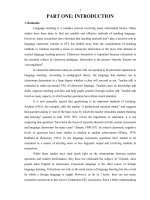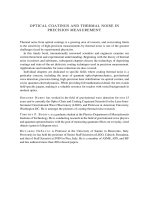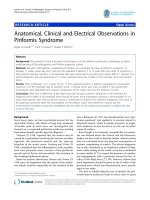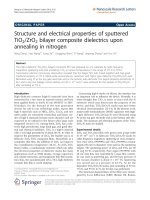- Trang chủ >>
- Khoa Học Tự Nhiên >>
- Vật lý
doctoral dissertation. optical and electrical interaction in self-assembled metal nanoparticle superstructures, 2008, p.72
Bạn đang xem bản rút gọn của tài liệu. Xem và tải ngay bản đầy đủ của tài liệu tại đây (5.22 MB, 72 trang )
TKK Dissertations 120
Espoo 2008
OPTICAL AND ELECTRICAL INTERACTIONS
IN SELF-ASSEMBLED METAL NANOPARTICLE
SUPERSTRUCTURES
Doctoral Dissertation
Helsinki University of Technology
Faculty of Chemistry and Materials Sciences
Department of Chemistry
Päivi Ahonen
TKK Dissertations 120
Espoo 2008
OPTICAL AND ELECTRICAL INTERACTIONS
IN SELF-ASSEMBLED METAL NANOPARTICLE
SUPERSTRUCTURES
Doctoral Dissertation
Päivi Ahonen
Dissertation for the degree of Doctor of Science in Technology to be presented with due permission
of the Faculty of Chemistry and Materials Sciences for public examination and debate in Auditorium
KE2 (Komppa Auditorium) at Helsinki University of Technology (Espoo, Finland) on the 23rd of
May, 2008, at 12 noon.
Helsinki University of Technology
Faculty of Chemistry and Materials Sciences
Department of Chemistry
Teknillinen korkeakoulu
Kemian ja materiaalitieteiden tiedekunta
Kemian laitos
Distribution:
Helsinki University of Technology
Faculty of Chemistry and Materials Sciences
Department of Chemistry
P.O. Box 6100
FI - 02015 TKK
FINLAND
URL: />Tel. +358-9-451 2572
Fax +358-9-451 2580
E-mail:
© 2008 Päivi Ahonen
ISBN 978-951-22-9361-2
ISBN 978-951-22-9362-9 (PDF)
ISSN 1795-2239
ISSN 1795-4584 (PDF)
URL: />TKK-DISS-2467
Multiprint Oy
Espoo 2008
AB
HELSINKI UNIVERSITY OF TECHNOLOGY
P. O. BOX 1000, FI-02015 TKK
.fi
ABSTRACT OF DOCTORAL DISSERTATION
Author Päivi Ahonen
Name of the dissertation
Manuscript submitted 12.2.2008 Manuscript revised
Date of the defence 23.5.2008
Monograph Article dissertation (summary + original articles)
Faculty
Department
Field of research
Opponent(s)
Supervisor
(Instructor)
Abstract
Keywords Nanoparticles, self-assembled monolayers, SECM, molecular switches
ISBN (printed) 978-951-22-9361-2
ISBN (pdf) 978-951-22-9362-9
Language English
ISSN (printed) 1795-2239
ISSN (pdf) 1795-4584
Number of pages 68 p. + 44 p.
Publisher Department of Chemistry
Print distribution Department of Chemistry
The dissertation can be read at .fi/Diss/2008/isbn9789512293629/
Optical and Electrical Interactions in Self-Assembled Metal Nanoparticle Superstructures
X
Faculty of Chemistry and Materials Science
Department of Chemistry
Physical Chemistry
Professor Jens Ulstrup
Professor Kyösti Kontturi
X
Self-assembly of molecules and supramolecules is one of the fundamental phenomena in chemistry, physics, biology
and material science. For example biological systems, like lipid bilayers of cell membranes and tertiary protein
structures are formed by spontaneous self-assembly. Conformation and properties of these assemblies can be affected
by changing the local environment of the structures. In the case of biological molecules, such an example would be
protonation or deprotonation by changes in pH. When changing the conformation, one often changes the collective
properties of the molecular assemblies.
In this thesis, the formation of functional nanoscale devices is approached from the self-assembly of molecules and
metallic monolayer capped nanoparticles into superstructures consisting of numerous nanoparticles. Stabilisation of
the individual nanosized particles is based on bonding between noble metals and thiol ligands. The desired chemical
characteristics and functionality of the nanoparticles is achieved by choosing the capping ligand layer and thus,
directing the interactions between the nanoparticles.
Both formation and functionality of the superstructures are studied in this thesis. Syntheses of silver and gold
nanoparticles capped with different ligands are included. Both the individual nanoparticles and the colloidal
superstructures formed by them were characterised by transmission electron microscopy (TEM), dynamic light
scattering (DLS), zeta-potential measurements and UV-vis spectroscopy. Characterisation of the electrical properties
of the self-assembled structures were carried out by scanning electrochemical microscopy (SECM).
The thesis is divided in three parts, considering first the formation of colloidal nanoparticle superstructures in
solution, then a photoresponsive switching nanoparticle structure and finally electron transport processes in nanoscale
films. In the first part, formation of nanoparticle aggregates via chemical and electrostatic interactions are studied.
The second part consists of assembly and characterisation of a nanoswitch built from nanoparticles and
photoisomerisable azobenzene molecules. In the last section of the thesis, electron transport processes in two
self-assembled nanoscale films are studied with SECM. The first system is a molecular self-assembled monolayer and
the second a film consisting of gold nanoparticles.
AB
TEKNILLINEN KORKEAKOULU
PL 1000, 02015 TKK
.fi
VÄITÖSKIRJAN TIIVISTELMÄ
Tekijä Päivi Ahonen
Väitöskirjan nimi
Käsikirjoituksen päivämäärä 12.2.2008 Korjatun käsikirjoituksen päivämäärä
Väitöstilaisuuden ajankohta 23.5.2008
Monografia Yhdistelmäväitöskirja (yhteenveto + erillisartikkelit)
Tiedekunta
Laitos
Tutkimusala
Vastaväittäjä(t)
Työn valvoja
(Työn ohjaaja)
Tiivistelmä
Asiasanat Nanopartikkelit, itsejärjestäytyneet yksikerrokset, SECM, molekyylikytkimet
ISBN (painettu) 978-951-22-9361-2
ISBN (pdf) 978-951-22-9362-9
Kieli Englanti
ISSN (painettu) 1795-2239
ISSN (pdf) 1795-4584
Sivumäärä 68 s. + 44 s.
Julkaisija Kemian laitos
Painetun väitöskirjan jakelu Kemian laitos
Luettavissa verkossa osoitteessa .fi/Diss/2008/isbn9789512293629/
Optiset ja sähköiset vuorovaikutukset itsejärjestäytyneissä nanopartikkelirakenteissa
X
Kemian ja materiaalitieteiden tiedekunta
Kemian laitos
Fysikaalinen kemia
Professori Jens Ulstrup
Professori Kyösti Kontturi
X
Molekyylien itsejärjestäytyminen eli molekyylirakenteiden spontaani muodostuminen on hyvin keskeinen
luonnontieteilijöitä kiinnostava ilmiö. Itsejärjestymistä esiintyy muun muassa biologisissa systeemeissä, esimerkkeinä
voidaan pitää vaikkapa lipidien asettumista levymäiseksi kaksikerrosrakenteeksi solukalvon muodostuessa sekä
proteiinien tertiäärisiä rakenteita. Muuttamalla tällaisten molekyylirakenteiden ympäristöä, biologisissa systeemeissä
esimerkiksi pH:ta, voidaan molekyylien konformaatiota eli avaruusrakennetta muuttaa. Konformaationmuutokset
johtavat tyypillisesti myös molekyylirakenteen kollektiivisten ominaisuuksien muuttumiseen.
Tässä väitöskirjassa tutkitaan toiminnallisten nanomittakaavan rakenteiden muodostamista itsejärjestäytymisen
avulla. Tutkitut systeemit ovat metallisista, orgaanisella ligandikerroksella stabiloiduista nanopartikkeleista
muodostuneita rakenteita. Ligandikerroksen kemiallinen luonne vaikuttaa rakenteiden muodostumiseen ja
toiminnallisuuteen ja se voidaan valita sovellukseen riippuen tilanteeseen sopivaksi. Tutkimuksessa käsitellään sekä
yo. rakenteiden muodostumista että niiden toiminnallisia ominaisuuksia.
Menetelminä itsejärjestäytyneiden yksikerrosten sekä nanopartikkelisysteemien sähköisten ominaisuuksien
tutkimisessa käytettiin sähkökemiallista pyyhkäisymikroskopiaa (SECM). Optisten ominaisuuksien tutkimisessa
käytettiin spektrofotometriaa sekä valonsirontamittauksia (DLS). Sekä yksittäisten nanopartikkelien että niistä
muodostuneiden rakenteiden muodosta ja koosta saatiin tietoa transmissioelektronimikroskopian (TEM) ja
valonsironnan avulla.
Väitöskirjan ensimmäinen osa käsittelee kolloidisten nanopartikkelirakenteiden muodostumista, kun nanopartikkelien
välillä on kemiallisia tai sähköstaattisia vuorovaikutuksia. Yhteenvedon toisessa osassa keskitytään optiseen
nanokytkimeen, joka on muodostettu sitomalla nanopartikkeleita toisiinsa fotoisomeroituvan
atsobentseenijohdannaisen avulla. Isomeroitumisreaktiossa partikkeleja sitovan molekyylin avaruusrakenne muuttuu,
jolloin myös partikkelien välinen etäisyys muuttuu. Väitöskirjan kolmannessa osassa tutkitaan
elektroninsiirtoprosesseja kahdessa erityyppisessä nanorakenteessa; atsobentseenijohdannaisen muodostamassa
molekulaarisessa yksikerroksessa sekä yksikerroksella stabiloiduista kultaklustereista muodostetussa kerroksessa.
Preface
The research presented in this doctoral thesis was carried out at the Laboratory
of Physical Chemistry and Electrochemistry, Helsinki University of Technology be-
tween January 2005 and February 2008. A period of four months in spring 2005
was spent at the University of Valencia. The work was financially supported by the
Kemira foundation and the European Commission.
First, I would like to express my gratitude to my supervisor Prof. Ky
¨
osti
Kontturi and all the co-authors of the publications included in this thesis. Special
acknowledgements go to Prof. David J. Schiffrin for sharing priceless pieces of his
experience and to Dr. Timo Laaksonen for giving his great support during this
time. Also Dr. Bernadette M. Quinn, Dr. Virginia Ruiz, Dr. Peter Liljeroth,
Dr. Christoffer Johans, Antti Nyk
¨
anen, Prof. Janne Ruokolainen and Dr. Jerzy
Paprotny are to be acknowledged for their contribution to this thesis. I would like
to thank Dr. Lasse Murtom
¨
aki for teaching me the basic knowledge on physical
chemistry, Prof. Jos´e Manzanares for hosting my stay in Valencia, Hannu Revitzer
for making the chemical analysis in some of the studies and Dr. Benjamin Wilson
for proof-reading the manuscript of the thesis.
The whole group of researchers, teachers, students and other members of FyKe
have earned my compliments for the atmosphere they have created to the laboratory.
The discussions and support from the fellow members of FyKe has really made the
time spent at the Laboratory of Physical Chemistry and Electrochemistry worth
remembering. Finally, I thank my family and friends for supporting me in my
choices and their endless patience with me.
This thesis was made out of enthusiasm for research and science.
P
¨
aivi Ahonen
Espoo, February 12th, 2008
i
ii
Table of Contents
List of Abbreviations vi
List of Symbols vii
1 Introduction 1
2 Colloidal nanoparticle superstructures via self-assembly 4
2.1 Dithiol induced nanoparticle cluster formation . . . . . . . . . . . . 4
2.2 Enhancing the stability of aqueous nanoparticle colloids . . . . . . . 9
3 Building a nanoswitch via self-assembly of nanoparticles 14
3.1 Photoisomerisation of azobenzene derivatised silver nanoparticles . . 14
3.2 Optical properties of nanoparticle clusters at quasi-static region . . 17
3.3 Optical switching of coupled plasmons of Ag-nanoparticles by pho-
toisomerisation of an azobenzene ligand . . . . . . . . . . . . . . . . 23
4 Electron transport processes in nano-scale films - characterisation
with SECM 26
4.1 Photoswitching electron transport properties of an azobenzene con-
taining self-assembled monolayer . . . . . . . . . . . . . . . . . . . . 26
4.2 Electrochemical gating in scanning electrochemical microscopy . . . 34
5 Conclusions 42
References 44
iii
List of Publications
This thesis consists of an overview and the following publications which are referred
to in the text by their Roman numerals.
I P. Ahonen, T. Laaksonen, A. Nyk
¨
anen, J. Ruokolainen and K. Kontturi,
Formation of Stable Ag-Nanoparticle Aggregates Induced by Dithiol Cross-
Linking, Journal of Physical Chemistry B, 2006, 110(26), 12954-12958.
II T. Laaksonen, P. Ahonen, C. Johans and K. Kontturi, Stability and Elec-
trostatics of Mercaptoundecanoic Acid Capped Gold Nanoparticles with
Varying Counter-Ion Sizes, ChemPhysChem, 2006, 7(10), 2143-2149.
III P. Ahonen, D. J. Schiffrin, J. Paprotny and K. Kontturi, Optical Switch-
ing of Coupled Plasmons of Ag-Nanoparticles by Photoisomerisation of
an Azobenzene Ligand, Physical Chemistry Chemical Physics, 2007, 9(5),
651-658.
IV P. Ahonen, T. Laaksonen, D. J. Schiffrin and K. Kontturi, Photoswitching
Electron Transport Properties of an Azobenzene Containing Thiol-SAM,
Physical Chemistry Chemical Physics, 2007, 9(35), 4898-4901.
V P. Ahonen, V. Ruiz, K. Kontturi, P. Liljeroth and B. M. Quinn, Elec-
trochemical Gating in Scanning Electrochemical Microscopy, Journal of
Physical Chemistry C, 2008,112(7), 2724-2728 .
iv
Author’s contribution
P
¨
aivi Ahonen has planned and carried out all the experimental work in publications
I, III and IV, apart from the synthesis of azobenzene derivatives. Ahonen corre-
sponded also for all theoretical work in publications III and IV. Publication II was
planned in collaboration with T. Laaksonen. In publication V, Ahonen carried out
the experimental work planned in collaboration with the other authors. Ahonen
was actively involved in preparation and writing of each manuscript.
Professor Ky
¨
osti Kontturi
Espoo, February 12th, 2008
v
List of Abbreviations
CCC Critical coagulation concentration
DLS Dynamic light scattering
DLVO Derjaguin-Landau-Verwey-Overbeek theory
DNA Deoxyribonucleic acid
FcMeOH Ferrocenemethanol
FcTMA
+
Ferrocenetrimethylammonium
MPC Monolayer protected cluster
MSA Mercaptosuccinic acid
MUA Mercaptoundecanoic acid
NC Nanocluster
NP Nanoparticle
PET 2-phenylethylthiol
SAM Self-assembled monolayer
SECM Scanning electrochemical microscopy
SERS Surface enhanced Raman scattering
STM Scanning tunneling microscopy
TBA Tetrabutylammonium
TEA Tetraethylammonium
TMA Tetramethylammonium
UME Ultramicroelectrode
UV-vis Ultraviolet and visible light
vi
List of Symbols
α
i
Polarisability of species i
β Decay constant
Γ(r) Radius dependant relaxation constant
Γ
∞
Bulk relaxation constant
Γ
+/−
Eigenvalue of the aggregate mode
∆z Thickness of the film
ε(ω) Dielectric function
ε
0
Permittivity of vacuum, 8.854 × 10
−12
Fm
−1
ε
1
(ω) Real part of the dielectric function
ε
2
(ω) Imaginary part of the dielectric function
ε
bulk
(ω) Bulk dielectric function
ε
m
Dielectric constant of the embedding medium
η Viscosity; polarisability of a nanoparticle
κ Inverse Debye length
Λ Dimensionless kinetic parameter
λ Wavelength of light
µ Electrochemical potential
˜µ Dimensionless electrochemical potential
µ
eq
Equilibrium electrochemical potential
µ
0
Standard electrochemical potential
Σ Dimensionless conductivity
σ Conductivity
σ∆z Conductance
ψ
0
Surface potential
ω
p
Plasmon frequency
A Correction factor for relaxation constant
a Nanoparticle radius
A
H
Hamaker’s constant
vii
C
i
Dimensionless concentration of species i
C
abs
Absorption cross-section
C
ext
Extinction cross-section
C
sca
Scattering cross-section
C
b
i
Dimensionless bulk concentration of species i
c
i
Concentration of species i
c
b
Total bulk concentration
c
b
i
Bulk concentration of species i
D Nanoparticle diameter
D
i
Diffusion coefficient of species i
d Center-to-center particle separation
e Elementary charge, 1.602 × 10
−19
C
E
0
Standard potential
E
eq
Equilibrium potential
F Faraday constant, 96485 Cmol
−1
h Surface-to-surface particle separation
I Current
i Dimensionless current
I
lim
Limiting current
I
C
T
Tip current for a conductive substrate
I
ins
T
Tip current for an insulating substrate
I
k
T
Tip current
J
i
Diffusion flux of species i
k
B
Boltzmann constant, 1.381 × 10
−23
JK
−1
k
ET
Rate constant of electron transfer
K
eff
Dimensionless effective rate constant
k
eff
Effective rate constant
K
0
Dimensionless standard rate constant
k
0
Standard rate constant
L Dimensionless tip-substrate separation
viii
m
e
Effective mass of electron
N Density of electrons
˜
N(ω) Complex refraction index
N
A
Avogadro’s number, 6.022 × 10
23
mol
−1
n
m
Refractive index of the embedding medium
R Ideal gas constant, 8.314 Jmol
−1
K
−1
; dimensionless radial distance
RG Dimensionless electrode shape factor
r Radius; radial variable
r
e
Radius of the electrode
r
g
Total radius of the electrode including the glass sheath
T Temperature; dimensionless time
t Time
V
attr
Attractive potential
V
rep
Repulsive potential
v
F
Fermi velocity
Z Dimensionless distance normal to the electrode surface
z Distance normal to the electrode surface; number of electrical charges
ix
1 Introduction
Self-assembly of chemical structures has attracted a great interest throughout the
history of nanotechnology. Good examples of self-assembled systems are biological
forms like cell membranes where the lipids assemble due to amphiphilic and steric
interactions and form a bilayer able to support the interiors of the cell. Similar
spontaneous self-assembly has been applied in nanotechnology to form new struc-
tures and the principle is commonly called the ’bottom-up’ approach. In this thesis,
simple metal nanoparticle superstructures and molecular monolayers formed by the
bottom-up approach are investigated. The formation and fundamental properties of
single nanoparticles are not the focus of this thesis, but the interest is on assemblies
formed of numerous particles and their properties. The emphasis is on controlling
the optical and electrical interactions between the nanoparticles embedded in the
superstructures, for instance by changing the conformation of the superstructure
in a controlled way. In addition, changes in the interparticle interactions lead to
changes in the properties of the whole superstructure.
The collective properties of metal nanoparticle superstructures have been ap-
plied in the development of different types of sensors. Sensors based on films of
nanoparticles linked to each other are typically chemiresistors, with their conduc-
tance dependant on the adsorption of certain chemical species into the film. [1] These
kinds of sensors may also be used as colourimetric sensors, if the sensing is based on
changes in interparticle distances, which also has an effect on the optical properties
of the nanoparticle assemblies. [2] Another sensor type is based on the enhance-
ment of the signal due to electrical or optical properties of the nanoparticles, e.g.
surface enhancement of Raman scattering (SERS) near nanopatterned silver sur-
faces. [3] SERS is based on the strong local electromagnetic field near the surfaces
of periodic nanostructures and allows even single molecule detection. Yet another
type of signal magnification occurs in hybrid materials consisting of biomolecules
and metal nanoparticles, for example, the signal obtained from a glucose-oxidase
enzyme has been enhanced by one order of magnitude. [4] This thesis consists of
1
studies considering the optical and electrical interactions in assemblies formed of
metal nanoparticles, thus introducing some of the fundamental properties behind
the function of above mentioned devices.
Metallic nanoparticles do not only provide an inert template for various chem-
ical functionalities but there are peculiar properties embedded in these nanomateri-
als themselves. [5] The most important properties, specific for metal nanoparticles,
are their low melting temperature (thermodynamic properties) [6], surface plasmon
absorption (optical properties) [7], room-temperature quantised charging (electri-
cal properties) [8], catalytic [9] and magnetic properties. [10] Also interesting are
the interparticle interactions and their effects on the superstructure properties. In
this thesis, a series of physicochemical studies on the collective optical and elec-
trical properties of superstructures consisting of silver and gold nanoparticles are
presented.
The first chapter considers the formation of colloidal nanoparticle superstruc-
tures driven by the interaction between the individual nanoparticles. Aggregation
of nanoparticles is induced by either chemical (publication I) or electrostatic (pub-
lication II) interactions. The nature of the interaction affects both the time-scale
of the superstructure formation and the final structure of the aggregate. [11] On
the other hand, the coagulation of the nanoparticles is often unwanted and thus the
basic knowledge of the cluster formation process is necessary.
The second part of this work introduces the basis for the optical properties
of both single nanoparticles and interacting particle clusters. The optical spectrum
of silver nanoparticles and nanoparticle clusters are examined in order to explain
the changes in plasmon absorption arising from the particle-particle interaction.
In publication III, a photoresponsive nanoswitch is built from silver nanoparticles
and azobenzene functionalised molecules. The most studied applications of the plas-
monic coupling of nanoparticles are different types of sensors [12] and the phenomena
they are based on, are described in this section.
The third part of the thesis is about the electrical properties of nano-scale films
and application of scanning electrochemical microscopy (SECM) [13] on studying
2
them. Two different approaches are presented; the first one (publication IV) shows
how to characterise and manipulate barrier properties of a self-assembled monolayer
built on Au(111) surface. The second approach (publication V) presents a study of
lateral conductivity of a film consisting of gold nanoclusters. The uniqueness of the
latter study is on controlling the film potential without electrical contacts.
Before closing the introductory section, the rather broad concept of a nanopar-
ticle needs to be clarified. Any particle from a metallic nanocrystal to biological
assembly, such as a liposome, having a size in the nanometre scale, can be consid-
ered as a nanoparticle. In this thesis however, the term nanoparticle has been used
exclusively to address particles having a metallic core and a capping monolayer of
some ligand surrounding the surface. [5,8] In publications I, II and III the particles
having 3-4 nm diameters have been called simply ’nanoparticles’ (NPs), whereas
the very small particles having a well defined core structure in publication V have
been referred to as either ’monolayer protected clusters’ (MPCs) or ’nanoclusters’
(NCs). [8,14, 15]
3
2 Colloidal nanoparticle superstructures via
self-assembly
2.1 Dithiol induced nanoparticle cluster formation
Nanoparticles and especially architectures constructed from nanoparticles are of
great interest for the possibility of making nanoscale devices by self-assembly tech-
niques. [2, 16–19] A well known method to form self-assembled nanoparticle struc-
tures is to cross-link nanoparticles with α,ω-functionalised ligands [20], such as dithi-
ols (see figure 2.1). Materials formed in this way maintain many of the unusual
properties of their original nanosized components because the MPCs remain seg-
regated. [18, 21] Some of the properties depend on the particle-particle separations
and are thus tunable, because the distance separating the particles is well defined by
the choice of the linker molecule. Both noncovalent [22–31] and covalent [1, 32–46]
thiol-bonding induced self-assembly of nanoparticles has been studied widely, with
most of the published work focussing on the electrical and optical properties of the
nanoparticle materials formed.
In publication I, aggregation of thiol stabilised 2.9 nm silver nanoparticles in-
duced by 1,6-hexane dithiol (figure 2.1 b) was studied by dynamic light scattering
(DLS). While in situ observation of direct thiol exchange seems unreachable, aggre-
gation caused by cross-linking of nanoparticles can easily be monitored. By linking
the aggregation rate of the nanoparticles to the rate of the thiol exchange reaction
on their surfaces, the kinetics of the thiol exchange can be probed indirectly with
DLS. Another way to study formation of nanoparticle clusters would be to monitor
their size microscopically, where samples must be taken and the reaction quenched
at appropriate time intervals. With DLS, one can follow the evolution of colloid
size in the same sample without the tedious work required to prepare one sample
for each time step. The reaction scheme for the aggregation process is presented in
figure 2.2. (Assumptions of the model are discussed in more detail later on in this
section.)
4
Figure 2.1: Examples of α,ω-functionalised molecules. (a) Mercaptoundecanoic
acid, (b) 1,6-hexanedithiol and (c) azobenzene derivatised dithiol (AZO2)
DLS measures the diffusion motion of the clusters, allowing the measurement
of the diffusion coefficient, from which the hydrodynamic radius can be extracted.
In publication I, an instrument based on the backscattering of light from the sample
was employed. Collecting the back scattered light avoids multiple scattering from
the particles and facilitates the measurement of strongly absorbing colloids. For
small metallic nanoparticles (diameter < 10 nm ), absorption dominates the extinc-
tion spectrum (see section 3.2), which lowers the intensity of scattered light and
causes difficulties in conventional light-scattering measurements. With instruments
based on back scattering one can characterise sizes even smaller than 2 nm. [47,48]
Another advantage of measuring back scattered light is the non-destructive nature
of the method compared to the conventional light scattering measurements. The
interaction between the nanoparticles and the 633 nm laser of the DLS instrument
was neglected, since the dodecanethiol capped silver nanoparticles employed in the
measurements do not absorb light at this particular wavelength.
In all of the measurements (figure 2.3), a rapid growth stage followed by lev-
5
Figure 2.2: A reaction scheme describing the two-step reaction of the nanoparticles
and dithiols. In phase I, thiol-functionalised nanoparticles are formed. In phase two,
the functionalised particles react further with the other functionalised particles thus
forming an aggregate. (Reprinted with permission from The American Chemical
Society)
elling out of the hydrodynamic radius was observed. After 60 minutes, a stable size
was reached when the solution was depleted of nanoparticles. The final hydrody-
namic radius was between 100 and 160 nm in all of the measurements. This size did
not change noticeably even after 24 hours, indicating that aggregates do not have
the tendency to coalesce to form larger structures in the time-scale considered.
A monomer-aggregate growth mechanism was assumed to allow the application
of a mathematically simple model. In the model, dithiol-functionalised particles are
denoted as the monomers, which are attached to the aggregates, thus forming larger
nanoparticle clusters (see figure 2.2). According to the Fick’s first law, the diffusion
flux J
i
of a species in spherical coordinates is defined as the product of the diffusion
coefficient D
i
and the concentration gradient of the species.
J
i
= D
i
dc
dr
(2.1)
When comparing the fluxes of the individual nanoparticles and the nanoparticle
clusters, the ratio of the fluxes stays rather high throughout the whole experiment,
because of the slow diffusion of the large clusters. In addition the number of clusters
6
Figure 2.3: Evolution of the hydrodynamic radius of the nanoparticle aggregate:
experimental results (dots) and calculated values (solid lines). The dithiol:NP ra-
tio was 94 (a), 47 (b) and 9 (c). Temperature was set to 10 (filled circles), 25
(open circles) and 40 (triangles). Arrhenius plot (d) is shown for the same cal-
culations. The dithiol:NP ratio was 94 (triangles), 47 (open circles) and 9 (filled
circles). (Reprinted with permission from The American Chemical Society)
is assumed to be constant throughout the experiment and thus, it is much lower than
the number of single nanoparticles at the beginning of the experiment and the growth
by combination of aggregates can be neglected. The combination of aggregates over a
longer time-scale was not part of this study. Dependence of the diffusion coefficient
on the cluster/aggregate size can be approximated from Stokes-Einstein relation
(equation 2.2), where k
B
is the Boltzmann constant, T is the temperature, η is the
viscosity of the medium and r is the radius of the particle. From this relation,
corresponding radii values for measured diffusion coefficients can be obtained. The
7
values of diffusion coefficients of single nanoparticles with ∼ 3 nm radii are the order
of 10
−6
cm
2
s
−1
whereas for nanoparticle clusters of 150 - 200 nm in diameter they
are two orders of magnitude lower.
D =
k
B
T
6πηr
(2.2)
Furthermore, all aggregates are assumed to be spherical and of the same size. While
there certainly will be a distribution in size, this assumption simplifies the model
greatly and reduces the number of parameters required. As mentioned above, si-
multaneous nucleation meaning a fixed number of nucleation points throughout the
experiment was assumed. A detailed description of the model is presented in pub-
lication I.
Despite all the simplifications, the model shows a good correlation with the
measured data. The rate constants for the thiol exchange, monomer desorption
and adsorption were used as the free parameters in fitting. Values corresponding to
monomer attachment and desorption were found to have only a minor effect on the
shape of the fitted curves and thus could not be fitted accurately. However, the rate
constant for the apparent thiol exchange reaction was found to vary between 0.6
and 4.0 × 10
−4
s
−1
and to follow the Arrhenius equation, from which the activation
energy of 46 10 kJ mol
−1
was calculated (figure 2.3 d).
To conclude publication I, new information of the formation of stable clusters
of thiol capped silver nanoparticles could be obtained by measuring the evolution of
aggregate size with dynamic light scattering. Under diffusion control, stable aggre-
gates of around 140 nm were reproducibly obtained via dithiol cross-linking of the
nanoparticles. The main objective of the study was to obtain kinetic information
about the thiol exchange reaction from an approach that combines the growth pro-
cess of a nanoparticle superstructure to the functionalisation of the nanoparticles
with dithiol molecules. The main assumptions in the model were that the reaction is
considered to proceed with dithiol-functionalised nanoparticles attaching to a grow-
ing nanoparticle cluster and that the cluster-cluster growth does not occur in the
8
same time-scale. In summary, we have demonstrated that dynamic light scatter-
ing provides a simple and effective means of probing the kinetics of place-exchange
reactions on nanoparticle surfaces.
2.2 Enhancing the stability of aqueous nanoparticle colloids
In water, coagulation of colloidal nanoparticles typically occurs due to the elec-
trostatic interaction between the nanoparticles’ ligand shells or their complexation
to each other. [24] Among the most studied applications for nanoparticle coagu-
lation are sensors, where the aggregation process of nanoparticles is induced by
DNA- [49–52] or other molecule recognition. [53,54] Aggregation for instance, causes
changes in the optical spectrum of the particles and increases electrical conductiv-
ity of a particle assembly (discussed in sections 3.2 and 4.2), which gives a way
to monitor specific interactions between molecules and nanoparticles. However, in
many cases, coagulation of the nanoparticles is not desirable and ways to avoid it
are needed. For instance, when studying the properties of individual nanoparticles,
the collective behaviour of nanoclusters in aggregates may affect the observed prop-
erties. Also when using nanoparticles in biological systems, for instance for target
amplification in biochips, [55, 56] non-specific coagulation is unwanted.
Typically small water-soluble nanoclusters are capped with carboxylic acid
terminated ligands and their solubility is highly dependant on the solution they are
immersed in. At low pH, the nanoparticles agglomerate due to protonation and
hydrogen bonding. [57] At high pH, the acid groups deprotonate and stabilise the
particle dispersion through electrostatic repulsion and prevent the aggregation of
the particles. Overlapping of the electrical double layers surrounding the particles
prevents them from approaching each other and agglomerating by attractive van der
Waals forces, thus determining the distance of closest approach of the nanoparticles.
The thickness of the electrical double layer surrounding the particles depends on the
salt concentration of the solution and a schematic of the structure of the electrical
double layer for a acid-capped nanoparticle is shown in figure 2.4.
9









